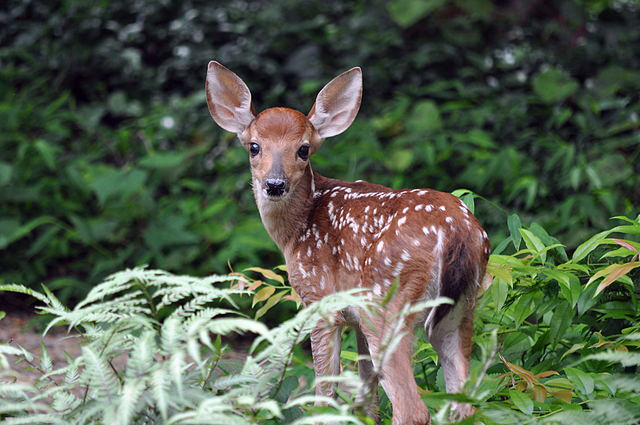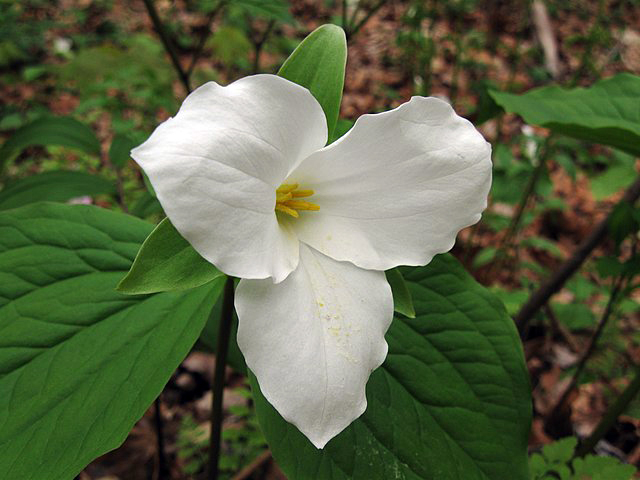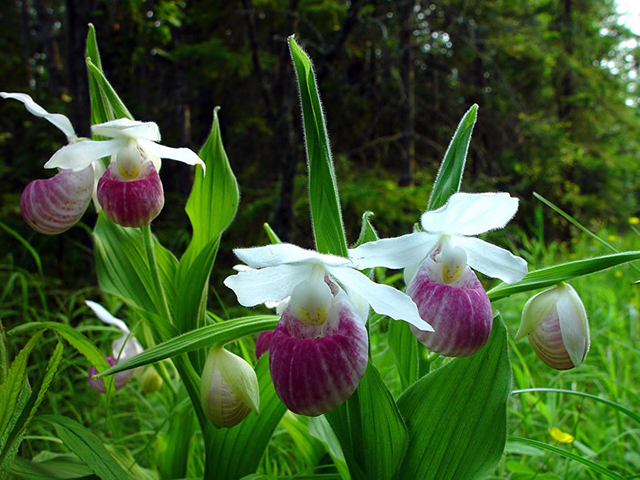Main Content
Sal Mangiafico, Rutgers Cooperative Extension
Introduction
White-tailed deer are a native species to our area. Their population was relatively low in the early 20th century, but increased markedly during the last 100 years (NJDEP, 2021). Likely, the lack of large predators like wolves has contributed to the increase in deer densities in New Jersey. However, our changing landscapes also make New Jersey more hospitable to deer. They are likely attracted to our “mixed” landscape: residential areas with lawns, landscape plants, and vegetable gardens mixed with forested areas or farm fields.
Why Would We Trade St. Patrick Some Deer for Some Snakes?
High densities of deer can be harmful to forests
One primary issue is that deer in high numbers can overbrowse the understory of our forests, removing tree seedlings and gobbling certain wildflowers like trillium and orchids (IDP, 2021). Often the understory that is left is composed of ferns or sedges—vegetation that deer don’t prefer. The upshot is that a forest may not be able to replace aging and dying trees if deer overbrowse tree seedlings. Some sensitive tree species affected by deer browse include Eastern white pine and other conifers, maples, and birch.
The difference that deer make on forest health can be seen in the results of exclosure studies where deer are fenced out of an area of the forest. Typically, areas with high deer densities tend to have a lower diversity in plant age and sometime lower plant diversity or different species composition when compared with fenced-off areas. Ecological disturbance by deer browse can lead to increased populations of invasive plant species as well as decreasing desirable plants like native wildflowers. One estimate is that densities as low as 10 deer per square mile can be problematic for forests to regrow (IDP, 2021).
Active forest management often includes significant costs to mitigate the effects of deer browsing. These may include replanting trees, installing exclusion fences, or capping the terminal bud of the sensitive tree species to protect them.
Deer are a vector for Lyme disease
While Lyme disease is transmitted to people and pets by the deer tick, or black-legged tick, white-tailed deer often serve as a primary host for these ticks (CDC, 2022). There has been some evidence that areas with higher deer densities may have higher rates of Lyme disease in people (Kilpatrick and others, 2014).
Car collisions with deer are common
These collisions can be expensive, potentially dangerous, and potentially traumatizing. Collisions with deer are particularly common in the fall, when mating season begins, and particularly in the early morning and around sunset. Motorists are advised to drive with caution, slow down when a deer is seen or when in an area where deer are prevalent, and when traveling at dusk and dawn (Kiefer, 2017; Moura, 2021).
Deer can cause significant damage to landscape and garden plants
A list of deer-resistant landscape plants can be found at njaes.rutgers.edu/deer-resistant-plants/ (NJAES, 2022). But be aware that hungry deer may be driven to eat a wider variety of plants when their favorites aren’t available. Deer can also devastate vegetable gardens.
Deer can cause significant damage to crops on farms
A report on case studies in New Jersey described direct damage to crops including everything from grains to vegetables to berries to ornamental nursery crops (Paulin and others, 2022). In addition, farmers reported indirect costs like losses from abandoning fields or crops, choosing alternate crops that may be less profitable, and investing in deer fencing. Also, farmers reported emotional costs such as frustration and depression if a crop is lost to deer damage.
Can deer serve as a reservoir for animal and human diseases?
It’s been reported recently that the SARS-CoV-2 (COVID-19) virus or antibodies for it are commonly found in white-tailed deer populations (APHIS, 2021; Anthes and Imbler, 2022). Fears include the potential that deer could serve as a reservoir for the virus that could lead to novel variants or that the virus could be passed from deer to people. APHIS (2021) notes that there is no evidence that deer or other non-human animals are playing a significant role in the spread of the virus to people. APHIS (2021) also notes that there were no reports of clinical illness associated with the virus in surveyed deer populations.
With some animal diseases, there is a fear that they could be passed from deer to ungulate domestic animals like cattle. Epizootic hemorrhagic disease (EHD) and chronic wasting disease (CWD) have been studied for this potential. It is not clear, however, that this potential method of transmission is of large practical importance.
As preventative methods, APHIS (2021) recommends taking practical measures such as not allowing contact between wildlife and domestic animals, not harvesting deer that appear sick or are found dead, and using person protective equipment (PPE) and avoiding brains and spinal tissue when processing deer.
Management
A high density of deer might be indicated by certain signs like a browse line in the forest, below which leaves have been stripped from trees; antler rubs on tree trunks; and a limited forest understory, or an understory dominated by few types of plants, like ferns and sedges.
For homeowners, there are limited opportunities to manage deer. Repellents like coyote urine may be effective but may need to be re-applied. Protecting young trees with bud capping in the fall or using tree tubes may be helpful. Keeping gardens or valued landscape plants away from wooded areas may be useful, as may be fencing out deer from gardens or valued landscape areas.
In a state like New Jersey, with mixed landscapes of residential communities, farms, and forests, large-scale effective management measures will likely involve statewide incentives or regulations. Hunting is an effective deer management tool but may not be possible in landscapes dominated by residential areas. Funding for deer fencing for farms and distribution of free tree seedlings may be helpful to protect crops or help replenish forests. There is a potential for sterilization of deer or other non-lethal approaches, though many of these face significant practical, financial, or political barriers.
Webinar
Get more information by watching the Earth Day Every Day webinar on deer management here: www.youtube.com/watch?v=ousIt8yBDvE&list=PLKx8NLAujm_lpOimXWyHxPD613H7HjZKd&index=30
References
Anthes, E., and Imbler, S. 2022 Feb. 7. Is the Coronavirus in Your Backyard? New York Times.
[APHIS] USDA–Animal and Plant Health Inspection Service. 2021. Results of Study on SARS-CoV-2 in White-Tailed Deer. www.aphis.usda.gov/animal_health/one_health/downloads/qa-covid-white-tailed-deer-study.pdf.
[CDC] Centers for Disease Control. 2022. Lyme Disease. www.cdc.gov/lyme/index.html.
[IDP] In Defense of Plants. 2021 May 2. “Deer & Forest Health,” Ep. 315. www.indefenseofplants.com/podcast/2021/5/2/ep-315-deer-amp-forest-health.
Kiefer, E. 2017. “Deer Mating Season In NJ Underway (9 Tips To Avoid A Car Crash).” Patch. patch.com/new-jersey/montclair/deer-mating-season-nj-underway-9-tips-avoid-car-crash.
Kilpatrick, H.J., Labonte, A.M., Stafford, K.C. 2014. The Relationship Between Deer Density, Tick Abundance, and Human Cases of Lyme Disease in a Residential Community. Journal of Medical Entomology, 51 (4):777–784.
Moura, C. 2021. “NJ Deer Collisions With Motorists Increase In 2021.” Patch. patch.com/new-jersey/holmdel-hazlet/chances-deer-collisions-while-driving-new-jersey.
[NJAES] New Jersey Agricultural Experiment Station. 2022. New Landscape Plants Rated by Deer Resistance. njaes.rutgers.edu/deer-resistant-plants/.
[NJDEP] New Jersey Department of Environmental Protection. 2021. White-tailed Deer in New Jersey. www.nj.gov/dep/fgw/deer.htm.
Paulin, J.B., Arbab, N.N., and B.J. Schilling. 2022. White-Tailed Deer and the Hidden Costs to Farmers’ Livelihoods: A Case Study of New Jersey Stories. Rutgers Cooperative Extension. New Brunswick. njaes.rutgers.edu/deer-costs-farmers-livelihoods/pdfs/deer-costs-farmers-livelihoods-full-report.pdf.



Image credits
Showy Lady’s Slipper (Cypripedium reginae). Photo by Charles Peirce. USDA. www.fs.fed.us/wildflowers/plant-of-the-week/cypripedium_reginae.shtml.
White Tailed Deer, Raleigh, NC. Photo by Clay Heaton. Creative Commons Attribution-Share Alike 3.0. commons.wikimedia.org/wiki/File:White_Tailed_Deer.jpg.
Trillium grandiflorum blooming in the Squaw Run valley, Fox Chapel Photo by Cbaile19. Creative Commons Zero, Public Domain Dedication. commons.wikimedia.org/wiki/File:Trillium_grandiflorum,_2020-05-03,_Trillium_Trail,_03.jpg.